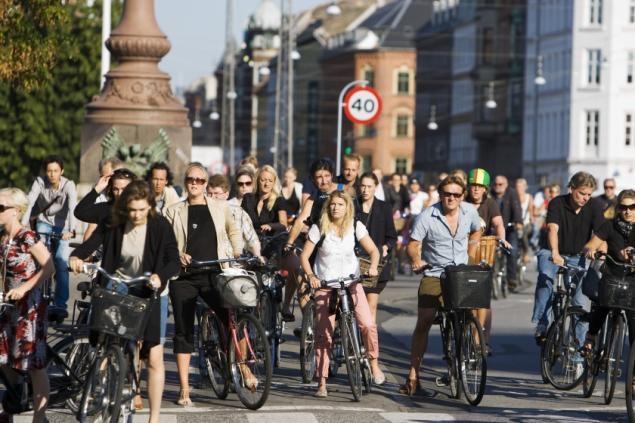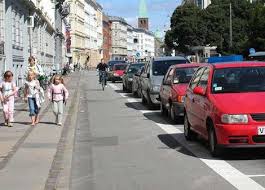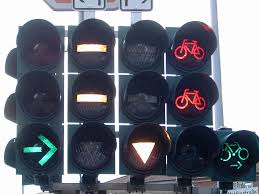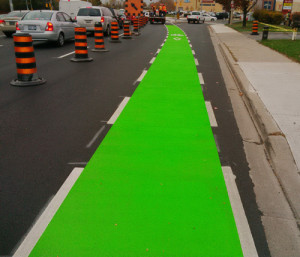 By Staff
By Staff
December 29, 2014
BURLINGTON, ON.
Roy Brooke is an avid cyclist who lives in Victoria BC. On a trip to Copenhagen Denmark he experienced physically separated bikes and cars with a dedicated cycle tracks.
Brooke tells his story: “Visitors to Copenhagen tend to notice that it is tough to take a photograph without a cyclist or bicycle in it. Cyclists seem to be everywhere, and statistics bear out the impression — 55 per cent of Copenhagers’ use bicycles each day and 41 per cent of people arrive to work or school by bike in the Danish capital.

In Copenhagen cycling is not limited. any any one demographic
“On a visit to Denmark I started to notice who was actually doing the cycling as much as their sheer numbers — old, middle-aged and young people, families with children, women in high heels, people doing chores, people just getting around; every possible segment of society seemed to travel by bike.
“As a parent, what surprised me were the many mothers and fathers in the downtown core with children on their bikes.
“At home in Victoria, I bike on quiet residential streets with my four-year old on the back in his carrier. However, I never venture downtown with him on my bike. In my judgment as a parent, neither the core of our city or the roads that lead to it are safe enough for me to travel by bicycle with my son.
“Yet in Copenhagen, a much larger and more bustling city than Victoria, families ventured into the busy core at all hours with children.
“I rented a three-speed cruiser at my hotel and set forth to find out why. After a few hours biking around Copenhagen, I had several clear impressions. Foremost, during the entire time I biked around town, I never once felt like I was running a gauntlet of death between parked cars on one side and speeding traffic on the other. Almost every route physically separated bikes and cars with a dedicated cycle track.
“In some areas, this was a bike lane on raised pavement. In others, simply but ingeniously, parked cars rather than people were the ones in the road nearest the traffic. This let bikers and pedestrians use the calm, safe space between parked cars and buildings.

Lanes created for bicycles where they don’t put riders in harms way and pedestrians have the sidewalks to themselves. In Copenhagen it isn’t a “them” and “us” – cars and bikes each have their place.

Traffic management includes instructions for cyclists.
“In places without physical barriers between cyclists and car traffic, thick lines painted on the pavement and wide cycle tracks kept cars at a distance, and all intersections were marked to prioritize cyclists.
“In a word, I felt safe.
“I also didn’t need to think much to bike. It was clear where I had to go because cycle routes were clearly delineated. It was clear when I had to go or stop because there were usually stoplights just for bicycles. And, it was clear where I could park or rent bicycles: just about anywhere.
“In short, things were designed not only for motorists but cyclists also.
“My overall impression is that Copenhagen’s physical separation of bike and car routes and having fully integrated design takes the “us versus them” out of cycling. I never felt irritated by motorists because I never came near them. I assume that I never bothered motorists, for the same reason. Pedestrians, motorists and cyclists thrived side by side because the urban system was built with everyone in mind.
“Above all, I understood why parents took their children into Copenhagen’s core on bikes. If Victoria had similarly modern cycling infrastructure, I would do the same here.
“Many other cities — Barcelona, Paris, Dublin for example — have made similarly large and fast leaps. Separated bike lanes, bike-share systems and lowered speed limits were common denominators in their success.”

Burlington has recently marked lanes to alert car drivers to merging bicycle traffic.
Is the time right for Burlington to make a similar leap? A start has been made. We have the chevron markers and there are now several bike lanes clearly marked with green paint alerting drivers to the merging of bicycle tragic,
During the recent municipal elections very little was heard from the cyclist lobby and as close to nothing from any of the candidates. Mayor Goldring seems to have assumed that he has learned a lesson after his flip flop on bicycle lanes along Lakeshore Road.
Burlington could join the ranks of leading, livable cities, not through a dialogue that is about cars versus bikes, but one based on the actual evidence: that proper, modern biking (and pedestrian) infrastructure makes life better for everyone.
New Street is scheduled to have some major infrastructure work done in the next few years. There was a proposal that dedicated bike lanes be part of that infrastructure upgrade – it wasn’t going to be cheap. The argument was to add the dedicated lanes while an upgrade was being done.
That item will come up during the budget debates in February.















It’s so refreshing when commenters actually use reasoned arguments to make their point. Thank you Chris Ariens!
Could we not do this more often rather than trying to shut down the discussion? Instead of referring to the issue of bike lanes as “rearing its ugly head”, perhaps we consider the possibility that the safety and health of children, pedestrians, cyclists, and drivers as our city grows is worth the time spent on continuing the conversation.
“Burlington could join the ranks of leading, livable cities, not through a dialogue that is about cars versus bikes, but one based on the actual evidence: that proper, modern biking (and pedestrian) infrastructure makes life better for everyone.”
A very astute observation, one that nearly all of the experts agree on. As a volunteer with the city’s Cycling Committee, I also think this is exactly the conversation we need to have.
When it comes to public investments, there are few that pay back as much as does investing in a safe, connected and inclusive transportation network that includes the bicycle, which is the most efficient way people can travel for medium length trips. For example this study from New Zealand, which concluded that investments in high-quality cycling infrastructure had a payback of 24x.
https://www.fastcoexist.com/3034354/the-cities-that-spend-the-most-on-bike-lanes-later-reap-the-most-reward?partner=rss
Fact: 50% of Burlington residents are within 10km or less from their workplace. Of those that are further away, a good number (myself included) use GO transit. The urban parts of the city are no more than 8km away from one of 3 GO train stations. That’s a 20-25 minute bike ride at a very easy pace for a non-athletic person.
Fact: 30% of Ontario residents cycle at least monthly. Yet only about 1-2% of all trips in the city are taken by bicycle. That’s a huge untapped potential. These are people who already cycle, but for whatever reason are choosing to travel another way.
Fact: More children in Burlington are driven to school than those who cycle or walk combined. By doing this, we are creating the dangerous situations for them which we are trying to avoid.
Fact: Increasing the cycling mode share to just 5% will enable us to facilitate half of the next 17 years growth with the same amount of road space. We’re going to spend $300 million in Burlington and $2.5 billion at the Region on roads in the next 10 years. Spending a small fraction of that on quality cycling infrastructure like that they have in the Netherlands should quite comfortably get us there.
Both Copenhagen and Amsterdam were heavy car cities in the 60’s and 70’s, and were becoming increasingly choked with traffic on the main streets and suburban areas. Kind of like Burlington today.
What changed for them? The people became fed up with the destruction of much loved places to make room for more cars and more parking lots, and even more, fed up with the continued death toll, especially of children in motor vehicle accidents.
Interestingly, European countries also have made a lot more progress than we have in safety for all road users, including motorists. That alone should be good enough reason to encourage us to try and replicate some of the successes they have had. Painting lines on the road is cheap, and makes it look as if we’re doing something for cycling, but ultimately we need to invest real money in making travel by bicycle safer and more comfortable if we want to reap the benefits. That means that pedestrians, bikes and cars each have their own place on the roads and paths, and everyone knows what to expect from one another.
I believe that we in Burlington are just as capable of building a great cycling city as are the people of Copenhagen, Groningen, Portland, Ottawa or Oulu (Finland). https://wintercyclingblog.org/2014/10/17/oulu-finland-winter-cycling-capital-of-the-world/
They are not smarter, not harder-working nor do they care about their cities more than we do. We have to demand better of our elected representatives. Burlington’s future, and our children – are worth it.
In my experience, as an ebike rider, I have found that most Burlington drivers offer ample room when passing me. I try to return the courtesy by hugging the curb as much as I can safely. However some potholes along the curb line can be quite large and deep. Some, on New Street for example, are as large as my tires and quite deep so I must avoid them.
I welcome the installation of the green lanes. The City chose an ecellent location to highlight the problem that bicyclists and drivers face. Both the southbound yield at the traffic lights and the turning lane farther down are both tricky spots to navigate through. I hope the next locations for green lanes are the highway exit ramp crossings.
I am tired of this illogical comparison to Europe and their cycling friendly roads. Of course they are. Everything there is situated closer in circular communties. In North America development is linear and separated by much more distance. Most people will only bike short distances. Our climate is not as moderate as Europe. Although I applaud making biking safer, expecting it to be like Europe is unrealistic. I’m not sure how reducing lanes, or painting things on the road to remind us that that a bike may be ahead, improves cycling in Burlington. To me it’s a waste of money.
Once again the issue of bicycle lanes rears its ugly head. It does not work to take existing roads and simply make the car lanes smaller to accommodate bicycle lanes. This is what the City is presently doing. The city seems more interested in appeasing the cyclist lobby than providing safe roads for motorists, pedestrians and cyclists.
With the same council in place we can expect more of the same.
Copenhagen’s cyclists do not seem to see the need for helmets – very few in sight!!
Re: “…the urban system was built with everyone in mind.”, that is the key point. Retrofitting to add capacity is a much greater challenge than designing capacity before construction, and it is not being done very well. Many bike lane markings in Burlington end suddenly, are poorly conceived, or are not being maintained. The green paint looks nice in the day time, but probably “disappears” when the sun goes down. Since I have seen no bicycle riders for more than a month, maybe it’s not that important? Burlington has little pedestrian traffic; when streets have sidewalks on both sides, as many do, why not simply designate one side as “pedestrian only” and the other side as “bicycles/ebikes”?